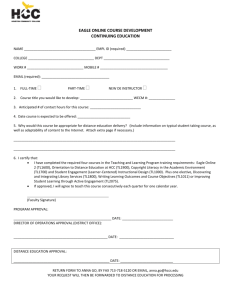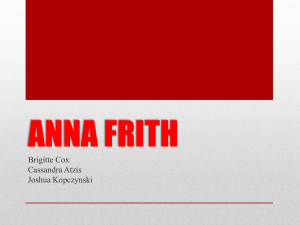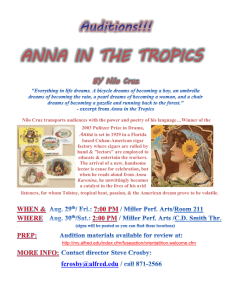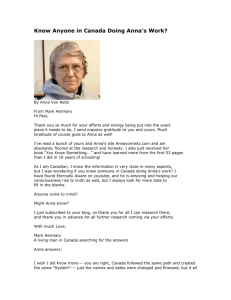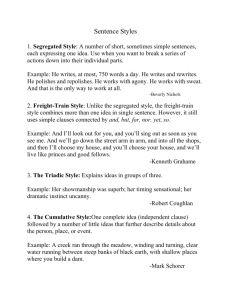Anna's Hummingbirds First, for those who are not sure how to
advertisement
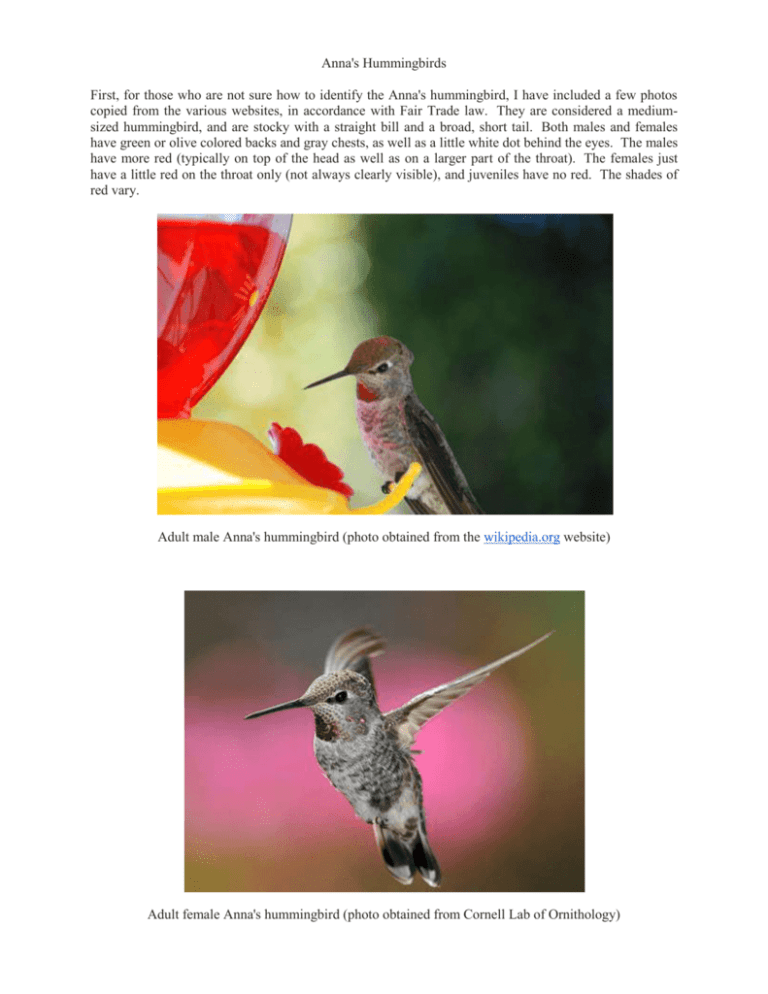
Anna's Hummingbirds First, for those who are not sure how to identify the Anna's hummingbird, I have included a few photos copied from the various websites, in accordance with Fair Trade law. They are considered a mediumsized hummingbird, and are stocky with a straight bill and a broad, short tail. Both males and females have green or olive colored backs and gray chests, as well as a little white dot behind the eyes. The males have more red (typically on top of the head as well as on a larger part of the throat). The females just have a little red on the throat only (not always clearly visible), and juveniles have no red. The shades of red vary. Adult male Anna's hummingbird (photo obtained from the wikipedia.org website) Adult female Anna's hummingbird (photo obtained from Cornell Lab of Ornithology) Anna's hummingbirds (obtained from the nationalgeographic.com website). Additional information below is listed in order of interest based on the results of the Anna's hummingbird survey that was already conducted: VEGETATION AND HABITAT OF THE ANNA'S HUMMINGBIRD The Anna’s Hummingbird can be found a variety of places, but are most commonly observed in yards, gardens, parks, residential area, eucalyptus groves, riverside woods, chaparral, savannas, and coastal scrub. They are attracted to hummingbird feeders and flowering plants, including cultivated species in gardens. If you are attempting to lure the Anna's hummingbird to your yard, you might consider planting flowering plants, such as: Fuchsias, Western columbine, Indian paintbrush, Pacific bleeding heart, Tiger lily, Manzanita, Orange honeysuckle, Penstemon, and Lupine, to name just a few. A few of the many shrubs that may attract Anna's hummingbirds include Red gooseberry, Oregon grape, Red-flowering current, Salmonberry, and Red huckleberry. Some of the trees that draw hummingbirds include Eucalyptus, Madrone, Black Hawthorne, Chokecherry, Bitter cherry, and Willows. NESTING HABITS: Females choose where to build nests (typically in spring), and use a variety of materials for nest building. Males do not participate in nest building. Nesting locations are often near a source of food (nectar) in a variety of trees, including but not limited to oak, sycamore, vines, shrubs, etc. She will rarely choose a coniferous tree. Nests are generally constructed from the center around the female, on the middle of a horizontal branch approximately 6-20 feet off the ground. She often builds the nest directly under leaves or other protective vegetation in an effort to hold in heat. Materials typically used in nest building include lichen, cattail, leaves, feathers, willow, moss, spider webs, and possibly even man-made articles (such as synthetic fibers and paint chips), as well as other various plant materials. The use of spider webs in the nest allows the nest to expand as the babies grow, and provides an opening that will close as the female comes and goes due to its stretchy material. Nests are typically one inch tall by 1.5 inches across, and take about a week to construct. The female lays two eggs, one to three times a year (depending upon location). The eggs are white and are roughly 0.5 inches long by 0.3 inches wide (the size of a jelly bean). Typical incubation time is approximately 16 days, while a full nesting period will last another 20 days. Chicks are born with almost no down feathers, eyes closed, and are extremely vulnerable during the early stages of life. NUTRITIONAL NEEDS/DESIRES In the wild, Anna's hummingbirds feast on insects, sap and nectar from blooming flowers. The majority of their protein needs are obtained from insects found on understory leaves, crevices, or those caught in spider webs, found in flight, or on flowers. Most of the insects they eat consist of small whiteflies, leaf hoppers, or midges. Some of their protein is also obtained from nectar, and therefore, during winter months when there are fewer insects and blooming flowers, the Anna's hummingbird may rely heavily on your feeder. So, what to feed? First off, it is recommended that we avoid adding red coloring or dye to food as it may be detrimental for the Anna's. Store bought hummingbird feeders typically have red colorful parts to attract the notice of hummingbirds; however, because nectar from flowers they feed upon is clear, the mix we use in their feeders should also be clear — a simple mix of sugar water. Furthermore, honey should not be used as a sweetener as it can contribute to bacteria or fungal growth when mixed with water. Table sugar makes an excellent mixture. Not all flowers have the same sugar content, and therefore hummingbirds will obtain different concentrations of sugar in nectar based on where they are feeding. Because they tend to move to a variety of flowers, it shows that they do not have a preference for a specific sugar content. That said, a 10 year old daughter of one of our survey participants did a well thought-out scientific study on preferences of the Anna's hummingbird. She put out 4 solutions with differing water to sugar ratios (4-1, 3-1, 2-1, and 1-1). She found the birds preferred the 2-1 ratio. While there are times when a ratio that high may be preferable (especially in colder weather), other studies have shown that while they may prefer the higher sugar content, they will not feed as often with a higher sugar solution. Therefore, it is recommended that generally a 4-1 water-sugar ratio is used, and can be increased to a higher concentration of sugar in colder months. When you initially want to attract a hummingbird, you can try a richer sugar solution, and then once they have found your source, you can reduce the sugar content in an effort to increase they're feeding frequency. If you mix small quantities of sugar water every day or two, there is no need to boil the water. But if you prefer to make larger batches and refrigerate part for later use, then it is recommended to use boiling water when making the mixture. The type of hummingbird feeder you use is not as important as the maintenance. It is best to use feeders that can be emptied and cleaned every day or two. Because the Anna's are usually extremely territorial with both feeding and breeding locations, it is best to put out multiple smaller feeders on different trees or windows so that more can feed, rather than a larger feeder with multiple feeding ports. Also important to those wishing to use feeders, it is highly recommended that the feeder be kept clean. Thoroughly washing a feeder every week or two is highly beneficial in keeping the birds healthy. Using a vinegar solution to clean the feeder periodically between thorough cleaning is also helpful. Food should be changed every two to three days for optimal cleanliness, and more frequently in hot weather. BREEDING RITUALS As part of the mating ritual, the male Anna's hummingbird puts on an elaborate dive display in an attempt to attract a female. It begins with an approximate 130 foot ascent, followed by a rapid plummet toward the female, at which time an impressive loud, high frequency sound can be heard. In 2008, two students from the University of California were able to prove that the sound made by the male while diving actually comes from the tail feathers rather than a previously thought vocalization from the male. Following the dive display that results in a receptive response from a female, the male will follow the female in a chase as she lures him toward her nest site, and perches again. Through a series of movements, the male will continue the flirtatiousness by swinging back and forth about a foot above the female and vocalizing an elaborate song. VOCALIZATIONS The Anna's hummingbird makes a variety of sounds, including sharp chirps and rapid chee-chee-cheechee-chee sounds. Their sounds are described differently on different websites, but all seem to agree that they consist of songs and single bursts of sound, depending upon the situation. During breeding, males will vocalize a song often described as scratchy, and when protecting their feeding territory, they will often send out threatening chatter of dominance. DISEASES Anna's hummingbirds can fall prey to Avian Poxvirus, a disease that is transmitted via contact with infected birds, food or water that has been contaminated by sick birds, or even coming in contact with surfaces that have been contaminated by carriers of the disease. The result will be lesions clustered on skin not covered by feathers, often around the beak, eyes, legs, or feet, as well as in the mouth or throat. Other diseases that can take their lives include fungal infections as a result of feeding from feeders that are not kept clean. A fungal infection can cause their tongue to swell and they will starve to death as they are unable to feed. For these reasons, cleaning feeders regularly with a 10% bleach solution is recommended so as to protect your hummingbird visitors. In addition to diseases, hummingbirds may suffer a premature death if they fly into windows, or are captured by prey - most frequently cats, raptors, large insects, snakes and lizards, and other birds. If you are able to keep your pets out of reach of a hummingbird territory, you will have a much greater chance of ensuring a longer life for your backyard Anna's. Furthermore, Anna's babies and eggs sometimes become a treat for rodents and other birds as well. OTHER Biggest question included in the category "other" in the previous survey was what has brought the Anna's hummingbird to our region in the recent past. Prior to the 1930s, the Anna's did not extend north beyond San Francisco. Its year-round presence as far north as Seattle was observed as early as the late 1960s, and it now winters over as far north as Vancouver, BC. The burning question is why has it come up this way? Most all of the answers I have found to date have to due with vegetation (over the years we have planted more and more flowering plants native to warmer climes), and our assistance with putting out feeders and keeping them up year round have made this a desirable location for the Anna's. Once a hummingbird has found a food source, it will defend that site and stay close to it (even if it is a small territory made up of a few fuchsia plants), and therefore, it is not motivated to leave. Once here in colder months, the Anna's will die without sufficient nutrients, so while it is able to enter a torpor state overnight if cold enough, the Anna's will die without food. If you have decided to keep a feeder out, please consider continuing that trend through the winter so they will not be in danger of starvation. Information gleaned for this educational document was obtained from the following sources: About.com website, retrieved from http://birding.about.com/od/Threats/a/Hummingbird-Predators.htm Audubon website, retrieved from www.audubon.org Clark, C. & Feo, T. (2008). The Anna’s hummingbird chirps with its tail: a new mechanism of sonation in birds. Proceeding of the Royal Society B Biological Sciences, 275(1637), 955-962. Cornell Lab of Ornithology website, retrieved from www.allaboutbirds.org Hummingbird Behavior, retrieved from www.hummingbirdworld.com/h/behavior.htm Hummingbird gardens website, retrieved from www.boskydellnatievs.com National Geographic website, retrieved from http://animals.nationalgeographic.com/animals/birding/annas-hummingbird/ USGS National Wildlife Health Center website, retrieved from http://www.nwhc.usgs.gov/disease_information/other_diseases/avian_pox.jsp WildBird magazine website, retrieved from www.hummingbirds.net/hainsworth.html Wikipedia website, retrieved from http://en.wikipedia.org/wiki/Anna's_Hummingbird

